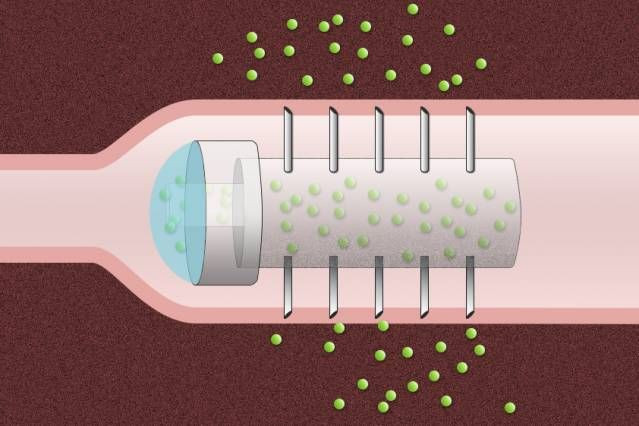Scared Of Microneedle Pills? Don't Be! It's Safer And Way Less Painful Than An Injection

Do you identify with toddlers who are brought into their doctor’s office kicking and screaming to get their flu shot? Don’t be embarrassed. Between 10 and 20 percent of the population are affected by trypanophobia — a persistent fear of injection — or a similar phobia. Wouldn’t swallowing a pill be so much easier than a needle? Researchers from Massachusetts Institute of Technology (MIT) and Massachusetts General Hospital (MGH) have developed a working microneedle pill, which may sound scary but is actually an easier and less painful method for administering vaccines that are normally injected.
“This could be a way that the patient can circumvent the need to have an infusion or subcutaneous administration of a drug,” Giovanni Traverso, a research fellow at MIT’s Koch Institute for Integrative Cancer Research, a gastroenterologist at MGH, said in a statement. “The kinetics are much better, and much faster-onset, than those seen with traditional under-the-skin administration. For molecules that are particularly difficult to absorb, this would be a way of actually administering them at much higher efficiency.”
Certain drugs, usually ones made with large proteins, have to be injected because when given in a pill form, they are broken down in the stomach before they are actually absorbed. Recent approaches to drug delivery have tried to use microparticles and nanoparticles to deliver “biologics,” a class of drugs that include vaccines, recombinant DNA, and RNA. However, efforts have proven too costly, and this method would require a new version for each drug. Scientists from MIT and MGH set out to design a capsule that could effectively deliver a number of biologics directly into the lining of the GI tract.
The microneedle pill’s prototype is a 2-centimeter-long and 1-centimeter in diameter acrylic capsule that includes a reservoir where the drug is stored. The capsule is surrounded by hollow, stainless steel needles that are around 5 millimeters long. The research team started to consider the possibility of a pill coated in needles after reviewing case studies on human patients who accidentally swallowed sharp objects. Since there are no pain receptors in the GI tract, the patient would not feel any pain if the drug was delivered in this area of the human body.
“This is a very interesting approach,” said Samir Mitragotri, a professor of chemical engineering at the University of California at Santa Barbara, who was not involved in the research. “Oral delivery of drugs is a major challenge, especially for protein drugs. There is tremendous motivation on various fronts for finding other ways to deliver drugs without using the standard needle and syringe.”
Researchers tested the safety and effectiveness of the microneedle pill by delivering insulin into the GI tract of pigs. A week after the pill was ingested, they discovered that it had moved throughout the entire digestive tract without causing any tissue damage. They also found that the pill had successfully injected insulin into the lining of the pig’s stomach, small intestine, and colon, which caused blood glucose levels to drop. The resulting drop in blood glucose levels was considered faster and larger than what would be achieved via a normal injection.
“The large size of these biologic drugs makes them nonabsorbable. And before they even would be absorbed, they’re degraded in your GI tract by acids and enzymes that just eat up the molecules and make them inactive,” said Carl Schoellhammer, a graduate student in chemical engineering and a lead author of the paper.
Source: Schroeder A, Schoellhammer C, Traverso , et al. Microneedles for Drug Delivery via the Gastrointestinal Tract. Journal of Pharmaceutical Sciences. 2014.
Published by Medicaldaily.com



























